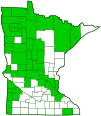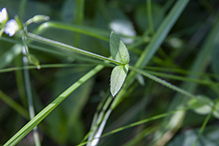field mouse-ear chickweed
(Cerastium arvense ssp. strictum)
Conservation • Wetland • Description • Habitat • Ecology • Use • Distribution • Taxonomy
Description |
Field mouse-ear chickweed is a common, native, forb. It occurs throughout the United States and southern Canada north to Alaska, but it is mostly absent from the deep south, the Great Plains, and the Great Basin. It is found in high quality natural areas, including in prairies, woodland openings, and tundra, and on lake shores and dunes. It is also found in man-made or disturbed (anthropogenic) habitats, including meadows, fields, and roadsides. It grows under full or partial sun, in moist to dry, sandy, rocky, or gravelly soil. Field mouse-ear chickweed is a 2″ to 12″ (5 to 30 cm) tall, perennial forb. At first, it has a vertical primary root (taproot) and forms a clump. Later, it develops a long-creeping system of tangled, short, underground, horizontal stems (rhizomes), and it forms a mat. In the first year, it does not flower. In the early spring of the second year, it first has the appearance of a mat, with non-flowering stems laying on the ground, just their tips curving upward (decumbent). Later in the spring, one or more flowering stems appear. Flowering stems are mostly 2″ to 8″ (5 to 20 cm) tall, sometimes up to 11¾″ (30 cm) tall, and they are erect or they curve upward at the base (ascending). They are round, green or straw colored, and usually branched near the top. The pubescence is variable, from densely hairy to entirely hairless. They are often densely covered with spreading to downward-bent, non-glandular hairs, mixed with gland-tipped hairs at the middle of the stem, with the glandular hairs becoming more dense toward the top. The leaves are opposite, stalkless, 1⁄16″ to 1″ (2 to 25 mm) long, and 1⁄32″ to 3⁄16″ (1 to 5 mm) wide. The leaf blades are linear to narrowly lance-shaped or inversely lance-shaped. They are usually sharply pointed but sometimes blunt at the tip. The midvein is conspicuously depressed on the upper surface. The upper and lower surfaces are usually hairy. The margins are untoothed. There is often a small tuft of shorter, narrower leaves rising from lower leaf axils. The inflorescence is a cluster or an open, branched arrangement (panicle) of up to 20 flowers. At the base of each inflorescence there is a pair of modified leaves (bracts). The bracts have thin, white to translucent margins, but they are otherwise similar to the leaves. Each flower is on a stalk (pedicel) that is ⅜″ to ⅝″ (10 to 17 mm) long, about 2 times as long as the outer floral leaves (sepals). The pedicel is curved just below the base of the flower, and it is densely covered with both glandular and non-glandular hairs. Each flower is about ½″ (12 mm) in diameter. There are 5 sepals, 5 petals, 10 stamens, and 5 styles. The sepals are green, narrowly elliptic, ⅛″ to ¼″ (3.5 to 6 mm) long, and tapered or angled to a sharp tip. They are covered with both glandular and non-glandular hairs. The petals are white, inversely egg-shaped, and ¼″ to ⅜″ (7.5 to 9 mm) long, about twice as long as the sepals. Each petal is deeply two-lobed at the tip and has distinct, translucent veins radiating from the base. The stamens have pale yellow anthers. Their stalks (filaments) are free, not fused together. The fruit is a slightly curved, narrowly cylinder-shaped, 5⁄16″ to 7⁄16″ (7.5 to 11 mm) long, 1⁄16″ to ⅛″ (2.5 to 4 mm) wide, seed capsule. It contains 15 to 30 or more kidney-shaped seeds. |
Height |
2″ to 8″ (5 to 20 cm) |
Flower Color |
White |
Similar Species |
Field chickweed (Cerastium arvense ssp. arvense) Mouse-ear chickweed (Cerastium fontanum ssp. vulgare) |
Habitat |
Moist to dry. Full or partial sun. Prairies, woodland openings, tundra, lake shores, dunes, meadows, fields, and roadsides. Sandy, rocky, or gravelly soil. |
Ecology |
Flowering |
Spring |
Pests and Diseases |
|
Use |
|
Distribution |
||
|
Sources |
|
| 6/7/2024 | ||
Nativity |
||
Native |
||
Occurrence |
||
Common and widespread |
||
Taxonomy |
|
Kingdom |
|
| Division |
Tracheophyta (Vascular Plants) |
Subdivision |
Spermatophytina (Seed Plants) |
Class |
|
Subclass |
Caryophyllidae |
Order |
Caryophyllales (Pinks, Cactuses, and Allies) |
Family |
Caryophyllaceae (Pink) |
Subfamily |
Alsinoideae |
Tribe |
Alsineae |
Genus |
Cerastium (mouse-ear chickweeds) |
Species |
Cerastium arvense (field chickweed) |
Subordinate Taxa |
|
|
|
Synonyms |
|
Cerastium alsophilum Cerastium angustatum Cerastium arvense ssp. fuegianum Cerastium arvense var. angustifolium Cerastium arvense var. fuegianum Cerastium arvense var. latifolium Cerastium arvense var. purpurascens Cerastium arvense var. strictum Cerastium arvense var. viscidulum Cerastium campestre Cerastium confertum Cerastium effusum Cerastium elongatum Cerastium fuegianum Cerastium graminifolium Cerastium latifolium Cerastium nitidum Cerastium occidentale Cerastium oreophilum Cerastium patulum Cerastium scopulorum Cerastium sonnei Cerastium strictum Cerastium subulatum Cerastium tenuifolium Cerastium thermale Cerastium vestitum |
|
Common Names |
|
field chickweed field mouse-ear chickweed |
|
Glossary
Ascending
Growing upward at an angle or curving upward from the base.
Axil
The upper angle where a branch, stem, leaf stalk, or vein diverges.
Decumbent
Reclining on the ground but with the tip ascending.
Filament
On plants: The thread-like stalk of a stamen which supports the anther. On Lepidoptera: One of a pair of long, thin, fleshy extensions extending from the thorax, and sometimes also from the abdomen, of a caterpillar.
Linear
Long, straight, and narrow, with more or less parallel sides, like a blade of grass.
Panicle
A pyramidal inflorescence with a main stem and branches. Flowers on the lower, longer branches mature earlier than those on the shorter, upper ones.
Pedicel
On plants: the stalk of a single flower in a cluster of flowers. On insects: the second segment of the antennae. On Hymenoptera and Araneae: the narrow stalk connecting the thorax to the abdomen: the preferred term is petiole.
Rhizome
A horizontal, usually underground stem. It serves as a reproductive structure, producing roots below and shoots above at the nodes.
Sepal
An outer floral leaf, usually green but sometimes colored, at the base of a flower.
Visitor Photos |
||
Share your photo of this plant. |
||
This button not working for you? |
||
Dan W. Andree |
||
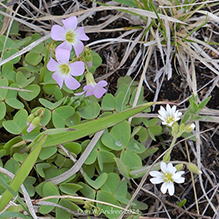 |
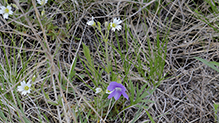 |
|
Field Chickweed and a Prairie Violet... This is another Field Chickweed I seen and a Prairie Violet. |
||
|
||
MinnesotaSeasons.com Photos |
||
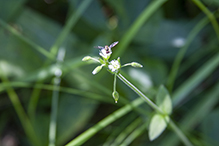 |

Slideshows |
|

Visitor Videos |
||
Share your video of this plant. |
||
This button not working for you? |
||
|
Other Videos |
||
Cerastium arvense: Field Chickweed or Field Mouse-Ear - Acker-Hornkraut |
About
Oct 13, 2021 The flora of Grey Hair-grass lawns on sand. Footage from Experimental Botanical Garden in Göttingen (Germany). |
Field mouse-ear (Cerastium arvense) - 2017-04-08 |
About
Apr 13, 2017 Cerastium arvense is a species of flowering plant in the pink family known by the common names field mouse-ear and field chickweed. Geo location: 52.06426 4.21959 |

Visitor Sightings |
||
Report a sighting of this plant. |
||
This button not working for you? |
||
| Dan W. Andree May 2024 |
Location: Norman Co. Mn. |
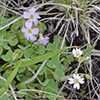 |
Dan W. Andree |
Location: A prairie in Norman Co. Mn. This is another Field Chickweed I seen and a Prairie Violet. |
 |
MinnesotaSeasons.com Sightings |
||
|

|
Created: 6/8/2024 Last Updated: © MinnesotaSeasons.com. All rights reserved. |
